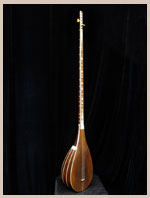SHARE WITH FRIENDS:
Uzbek national dutar instrument Dutor- The word sounds in magic
Dutor - (Persian - two strings) - a stringed hertma national musical instrument. It is widespread among the Uzbek, Tajik, Uyghur, Turkmen and Karakalpak peoples. The Uzbek dutar stands out from other instruments with its gentle, elegant and juicy voice. It is mainly made of mulberry, large wood. The resonator of the instrument body is made of 8-12 thin ribs glued side by side. A thin lid is closed on the upper, open part of the skull, and the skull is connected to the handle through the throat. 13-17 curtains are attached to the long and slender handle of the dutor. The skull and stalk are engraved with mahogany patterns made of bone and pearls. The strings are woven from silk work. They are set to tanovor sozi quarta, munojot sozi quinta, and koshor sozi unitor. In Uyghurs, the dutar is in a larger form.
In Turkmenistan, only carvings, drills, and in Khorezm and Karakalpakstan, small skulls are found along with ribbed dutars. The dutar is a soloist and an accompanist, which requires great performance skills from the musician. Dutor has a variety of performance techniques such as single, double, wrist, bidratma, reverse tattoo. The first written information about the dutar can be found in Chapter 16 of Navoi's contemporary Zaynulobidin al-Husseini's pamphlet, The Scientific and Practical Rules of Music. The names of such musicians as Yusuf Mavludi Dutoriy from Herat and Mirquliy Dutoriy from Mashhal, who created in the XVI-XVII centuries under the pseudonym "Dutoriy", are preserved in the sources. Currently, the unique style of national dutar performance is reflected in the 4 main schools of Andijan, Tashkent, Samarkand and Khorezm. Dorip dutarchi, M.Najmiddinov, O.Rustamov, K.Jabborov from the Andijan school in the XX century calf ”,“ Koshtor ”, Solikhon Haji, one of the great representatives of the Tashkent school. Dutar alt is a type of traditional dutar that originated in the 1930s. The wires are made of kapron or other polymer yarns. Wooden or bone curtains placed in chromatic order on the handle are glued. His repertoire includes mainly harmonized folk melodies performed by Uzbek composers and piano accompaniment. On the basis of this dutar, various types of dutar bass and dutar double bass were developed for Uzbek folk composers.
SOURCE: komilaxon.blogspot.com
